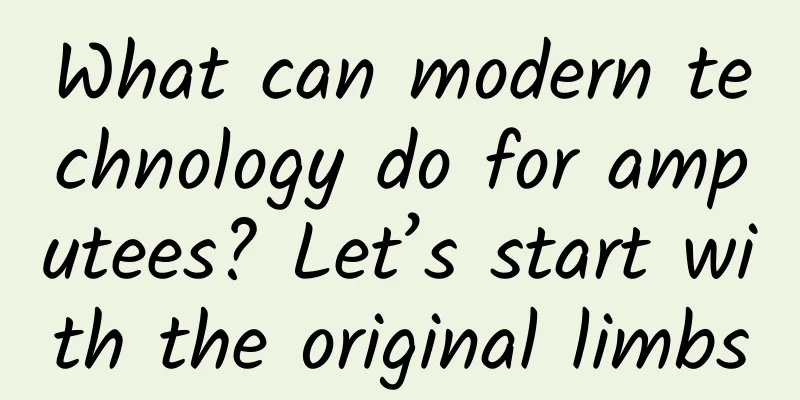What can modern technology do for amputees? Let’s start with the original limbs

|
Produced by: Science Popularization China Author: Hu Xuhui ( Suzhou Institute of Biomedical Engineering and Technology, Chinese Academy of Sciences ) Producer: China Science Expo When the alarm goes off in the morning, you turn off the alarm, get up, brush your teeth, tie your shoes, and get ready to go out... This is a scene that most people face every day. If you are careful enough, you may find that the basis of all these activities is people's flexible use of their hands. In real life, the function of hands is far more than this. It also helps us express more accurately and even becomes a cultural symbol. But these are common actions for most people, but for others, they are extremely difficult or even impossible tasks - they are the disabled people with hand disabilities. An illness or accident, or simply congenital factors, may cause problems with their hands and make them unable to use them normally. Faced with this situation, people always use various means to help them, and the most helpful thing for them may be prosthetic limbs. Today is National Disabled Persons' Day. Let's talk about what modern technology can do for amputees. (Photo source: veer photo gallery) 1. Evolution of prosthetic hand technology If we classify upper limb prostheses by the number of functions they have, the most simple and price-friendly ones should be decorative prostheses . They are usually made of silicone and have a good look and feel, but as its name suggests, that's all. (Decorative prosthetic hand image source: veer gallery) The most practical mainstream prosthesis is the cable-controlled prosthetic hand. It is usually worn by binding the user's shoulders, with the straps tied to the user's shoulders extending all the way to the finger joints of the prosthesis. The user controls the tightness of the traction rope by moving the opposite shoulder blade to achieve grip. However, it is cumbersome to wear, painful due to movement friction, and requires a lot of practice to adapt to the counterintuitive operation method. Cable-controlled prosthetic hand control principle Image source: Reference [1] If we use the horizontal axis to represent ease of use and the vertical axis to represent functionality, we will see that there is still a big gap between decorative prostheses, cable-controlled prostheses and normal limbs. If we want to create a new type of prosthesis that is as close to the original limb as possible in terms of function and ease of use, this requires the prosthesis to be controlled in a way that is intuitive to the user and has richer movement properties. To achieve this, perhaps we need to first understand how we control our limbs for clues. Functionality and ease of use distribution of decorative prostheses and cable-controlled prostheses (Image source: self-made by the author) 2. How do humans control the movements of their native limbs? The basic unit of information transmission media in the human body is the neuron. After receiving the influence of upstream neurotransmitters through dendrites and entering an excited state, the sodium ion channels on the capsule open, and a large number of positively charged sodium ions flow in, some of which are pushed to the axon part with a lower potential. Stimulated by sodium ions, the sodium ion channels on the axon open one by one until the axon terminal. The calcium ions at the axon terminal bind to proteins and release neurotransmitters in the vesicles. The released neurotransmitters affect downstream target cells. Motor nerve signaling process (Image source: Reference [1]) If we simplify this process into a diagram from the perspective of changes in membrane potential, it looks something like this: Action potential waveform of a single motor unit (Image source: Reference [1]) This transmembrane potential pulsation with a special waveform is called an action potential. Although the transmission process is not exactly the same due to differences in axon structure and neuron length, we can generally regard our nervous system as such an information highway: the signal is sent by the brain, transmitted to the peripheral nervous system through the spinal cord, and ultimately controls the contraction of the corresponding skeletal muscles to complete the corresponding action. Limb loss means that the brain is still sending signals, nerves are still transmitting signals, and muscles are still contracting, but the corresponding receiving end is offline. 3. How do amputees control the movement of their prosthetic limbs? At this point, things seem to be getting clearer. At this point, some smart friends may ask, since the signal is generated by the brain, can't we just implant the EEG signal acquisition device into the brain to read the information, and then convert it into machine instructions for the prosthesis to execute? But in fact, this process is simple to say, but it is extremely difficult to achieve - this is what the most cutting-edge brain-computer interface technology is currently studying. Brain-computer interface technology (Image source: veer Gallery) The problem involved in this technology is that, first of all, to implant the EEG signal acquisition device into the brain, an invasive brain-computer interface surgery is required. This surgery has huge potential harm and physiological rejection risks, and there are also many ethical issues (such as personal privacy, etc.); secondly, the signal acquisition and decoding technology is still very immature. How to correctly identify EEG signals and how to decode these signals? These are unresolved problems; in addition, even after the acquisition device is successfully implanted, it will gradually be wrapped by glial cells, which will seriously affect the accuracy of signal acquisition, and this problem can only be solved by opening the skull again. Therefore, for the time being, invasive brain-computer interfaces are still in the theoretical research and experimental stage of technology. It is no closer to our lives than the immigrants to Mars. Although non-invasive brain-computer interfaces based on electroencephalography and transcranial magnetic stimulation have already appeared, even without considering portability, searching for local limb signals near the human body's central processor in a non-invasive way would be, as Professor Xu Kedi of Zhejiang University said, like looking for the voice of a specific singer in a choir's singing. However, although it is difficult to identify limb signals in the brain, it does not mean that it is impossible. As the signal is transmitted from the brain, the action potential directed to the local limb separates from other signals and eventually reaches the muscle joint and spreads to both sides along the muscle fibers. For upper body prostheses, the verticality of the signal here will be much higher. And the action potential on the muscle fiber will also spread to the surface of the skin along the subcutaneous tissue such as fat. This brings a good news, that is, physiological electrical signals related to movement intention can be collected on the surface of the skin without invasive means. And because these signals come from muscles, they are called surface electromyographic signals [3]. The signal is already there, and it sounds like we only need to decode the surface electromyographic signal from the amputee's stump and convert it into corresponding mechanical instructions for the prosthesis to execute. However, decoding the surface electromyographic signal is not an easy task. Principle of electromyographic signal generation (Image source: Reference [1]) 4. How to decode the electromyographic signals of residual limbs? In order to better understand how scientists decode the movement intention contained in electromyographic signals, let's first take a simpler example. If the three-dimensional model features in the picture represent a sound signal, our task is to analyze which instruments are used in it. Obviously, this is a clueless task. Even if the information in this picture is rich enough, and the three key information of time, frequency, and loudness are all at a glance, it is still impossible to distinguish the types of instruments. Three-dimensional model of sound signal regarding time, frequency, and loudness (Image source: Reference [1]) If we look at this model from another angle, the horizontal axis is frequency and the vertical axis is loudness. We can get the frequency response curve of this song at a certain moment, which is the linear superposition of the frequency response curves of each instrument at that moment. In other words, if we are familiar with the frequency response curve models of different instruments, we can use this to determine which instruments are included at this moment. Of course, in fact, each of us is familiar with them (but not in the form of audio waveforms), because our brains have stored a large number of such models and successfully extracted model features from them. This is why even if the distortion, overload and other effects of electric guitars vary greatly, we can still distinguish them through hearing. Composition of electromyographic signals and corresponding motor unit action potentials (Image source: Reference [1]) Now let's look at this electromyographic signal graph again. Although it is still a bit confusing, it seems to have some clues. We already know that it is a linear superposition of electromyographic signals of multiple motor units, so if we can get the electromyographic signal model of these motor units and extract the features, we can reversely find out the action intention contained in this mixed signal and execute it. But there is no way to get enough models at present. This problem is not unsolvable in theory. Many practitioners are working hard for it. The current mainstream technical path is blind source separation based on independent analysis. This sounds obscure, so let's go back to this music again. Assuming that we don't know any common sense about rock music and its instruments now, it means that it is difficult for us to distinguish which sounds come from the same instrument. For example, the high part of the bass and the bass part of the guitar may be regarded as coming from the same instrument. So how do we tell the difference? The answer is to listen more. Open the music software and listen to more songs of this band, and compare different sections. At the same time, you also need to get the mixed audio signals collected in front of different instruments during synchronous sound recording. In this way, through the rough classification of timbre, combined with the distance information of the instrument audio collected by different microphones, you can accurately distinguish which sounds come from which instruments. Blind source separation based on independent analysis is roughly the same. The microphones at different positions collect the linear superposition of different weights of these instrument signals, and these weights form a matrix. As long as the number of microphones is greater than or equal to the number of instrument types, the most realistic matrix can be obtained through continuous iteration, and the mixed signals of these unknown instruments can be disassembled as before by solving the matrix equation. Blind source separation has applications in music separation, human-computer voice interaction, etc. The technical path is there, and there are relatively mature commercial applications in the audio field. Everything looks beautiful, doesn't it? But in the example of music, we talked about a premise, that is, the number of microphones in different positions must be greater than or equal to the number of musical instruments. This sentence can be transformed into the number of signal collectors that is greater than the number of source signals, and the fewer the relative number of collectors, the more ambiguous the results. This is usually easy to achieve in the audio field where the number of source signals is small, but for the human body, the number of motor units that serve as source signals below the elbow alone is already thousands. It is completely unrealistic to put a matching number of collectors into a prosthesis. So what to do? The answer may be compromise, which is what the third most common type of prosthetic hand, the myoelectric prosthetic hand, does. It collects surface EMG signals on the flexor and extensor sides through two EMG sensors, performs envelope analysis on the collected EMG signals, folds the curve below the horizontal axis, and then extracts low-frequency features. In this way, it is sufficient to identify the three gestures of wrist inversion, wrist valgus, and grasping. Based on this, various commonly used gestures in life are preset in the prosthesis, and they are switched back and forth according to the scene when used. Just like we do in the music app, previous song, next song, play. Although the control is still not intuitive enough, compared with the cable-controlled prosthesis, the myoelectric prosthesis makes it possible to operate multiple gestures deftly. The control principle of existing commercial myoelectric prosthetic hands (Image source: Reference [1]) So far, we have roughly introduced the products on the upper limb prosthetic hand market. Are there any regrets at this stage? Yes. For example, once the amputation site rises to the upper arm, this solution is no longer suitable; for example, the intelligent bionic hand still cannot sense temperature, force, position, etc. like a real hand. In addition, there are still problems in practical applications of gesture recognition based on electromyographic signals. For example, limb movement and the compression of the skin by the receiving cavity may produce motion artifacts in the electromyographic signal. This is because the electrical signal must pass through the subcutaneous tissue to propagate to the skin surface, and the compression will change the morphology of the subcutaneous tissue. This is like the sound suddenly changing the medium during propagation, which will cause the electrical signal to deform, making analysis more difficult. But this is indeed the current status of commercial myoelectric controlled prostheses. 5. Which prosthetic hand is a better choice for current amputees? So far, we have introduced the three most common prosthetic hands on the market, including decorative prosthetic hands, cable-controlled prosthetic hands, and myoelectric prosthetic hands. So are myoelectric prostheses definitely better than traction prostheses? Myoelectric prostheses can achieve more gestures to cope with different scenarios. So it can be said that it is more technically advantageous. But we have not yet talked about its important attribute as a commodity, that is, the price of myoelectric prostheses. Since prostheses still need to be highly customized for individuals, the combined labor and material costs make the price of traction prostheses reach thousands of yuan. The R&D cost of myoelectric prostheses is even higher. Obviously, compared with mass consumer goods, it is much more difficult for upper limb myoelectric prostheses to reduce costs through scale. At present, the average price of advanced foreign myoelectric prosthetic hands in China is about 200,000 to 300,000 yuan, and the channel price in some areas may exceed 500,000 yuan. In extreme cases, you may even receive a quote of 700,000 yuan. The sales channel management advantages of domestic brands are indeed obvious, and the selling price is about 1/5 of this figure. But it is obviously still not cheap. In fact, when a person loses an arm, his or her ability to work is greatly affected, so the actual per capita disposable income of forearm amputees is very low. But more expensive and technologically advanced prostheses cannot well make up for the user's missing labor. In a paper titled “Key Factors in Upper Limb Prosthesis Abandonment,” Dr. Elaine Biddiss pointed out[7] that approximately 20% of users abandoned their upper limb prostheses within two years. In another paper focusing on people with limb impairment in Norway, Dr. Kristin Østlie provided similar data and further added that since “wearing” is considered “using,” a considerable number of disabled people in the statistical population only use prostheses for decoration, so the functional use rate of prostheses is actually lower. Therefore, if economic conditions are limited or the myoelectric signal is weak, the cable-controlled prosthesis can still assist the amputee's daily life needs. If there are higher requirements for aesthetics and functionality, and the residual limb's myoelectric signal meets the prosthetic control requirements, the myoelectric prosthetic hand is more recommended. If you care more about the natural integrity of the limb's appearance, then the more realistic appearance of the cosmetic hand is still worth considering at present. Of course, the continuous development of science and technology will definitely bring more convenience to people with disabilities and allow them to have a diverse future. References: 1. "What options do amputees have at the moment? And what is the cost?" (2023) Bilibili 大氣免成_1004 (authorized) 2. "Assistive Devices Intelligence Research Issue 3: History, Current Situation and Prospects of Prosthetics and Orthotics in my country" (2020) National Rehabilitation Assistive Devices Research Center 3. The Extraction of Neural Strategies from the Surface EMG. (2004) Dario Farina et al. 4. Independent Component Analysis: An introduction. (2018) Tharwat Alaa. 5. Research on Key Technologies of Human-Machine Collaborative Dexterous Myoelectric Prosthesis (2022) Hu Xuhui 6. The Extraction of Neural information from the Surface ENG for the Control of Upper-Limb Prosthesis: Emerging Avenues and Challenges. (2014) Dario Farina, et al. 7. Upper-Limb Prosthetics: Critical Factors in Device Abandonment. (2007) Elaine Biddiss, et al. 8. Prosthesis rejection in acquired major upper-limb amputees: a population-based survey. (2012) Kristin Østlie, et al. |
<<: How does the brain recognize people by their voice?
>>: Wang Xuan: The tactical life of the "contemporary Bi Sheng"
Recommend
Use this trick well and your user conversion rate will increase exponentially!
Let me tell you a story first: Smart little begga...
Is the more expensive the coffee, the better? How many misunderstandings do you have about coffee?
Is more expensive coffee better? ——How many misun...
If an electric car is not used for a long time, the battery will "starve to death"?
Audit Expert: Wang Jinlu, Director of Power Suppl...
C4D product performance first issue [HD quality with material]
C4D product performance first issue [HD quality w...
Lenovo's mobile phone business is unlikely to replicate the PC myth after missing out on a good development opportunity
According to the latest data from IDC, Lenovo'...
The effectiveness and traffic conversion of TikTok advertising in APP!
Recently, advertisers of e-commerce apps seem to ...
7 operational ideas for community operations! (Down)
7 operational ideas for community operations (Par...
As the number of fans in Greater China continues to decline, what is the point of Apple betting on India?
Recently, Apple released its first quarter financ...
How much can AI help you fill in your college entrance examination application form? Just a supplement!
□ Zhang Gailun, a reporter from Science Times The...
How to read palms and faces "Shiyuan teaches you how to read faces" to identify people
The video version of Mr. Wang Shiyuan’s high-qual...
A must-see for bosses/directors! 18 cheating tricks for Internet marketing
Practitioners of online advertising in China all ...
Huawei responds to US ban on Chinese 5G: Restricting Huawei will not make the US stronger
[[265442]] The US blockade of China's 5G tech...
The nine sons of a dragon don't look like dragons? I was torn when I knew the truth!
As the saying goes: The dragon has nine sons, eac...
Space and surplus coexist, and the Matthew effect in the power battery industry begins to emerge
With national support and promising prospects, an...
It’s been seven years. Do you still remember the “rabbit” that lived on the moon?
"Hi! Good night this time!" Seven years...









